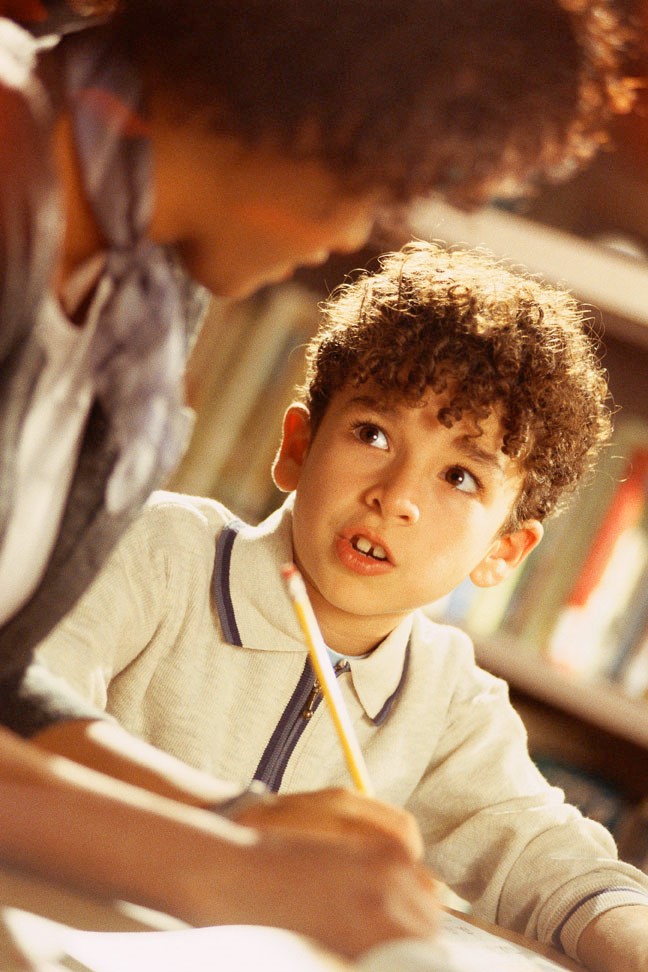As a teacher, you probably spend a lot of time preparing engaging lessons, grading student work, and attending professional development. But, do you take the time to think about the questions you are asking your students? Do you pay particular attention to what they are asking you? Asking good questions and promoting discourse is an integral part of the teaching and learning in a classroom. It is worth your time! See some tips below on how to get started:
Observe another teacher. Pay particular attention to the questions the teacher asks the class and also individual students. Were the questions effective? How can you tell? Did the questions result in single answers or explanations from the students? Were you able to tell if the students had true understanding of the mathematical topics? What kind of questions would you suggest to the teacher?
Reflect on the questions that you pose in your own classroom. Use the technique of Question-Listen-Question. Get an audio recorder, and record yourself teaching. When reviewing the conversation, concentrate on the interaction after you pose a question as a means to evaluate whether or not your questions promote deeper mathematical thinking. Do your questions prompt students to develop deeper understanding or to get them to a desired answer? Is the student learning from the series of questions? Listen to students' responses and guide them based on what they are thinking. For examples of effective initial and follow-up questions, see
Questioning Our Patterns of Questioning and
Questioning Your Way to the Standards.
Set up classroom norms so that everyone knows their role in the classroom. The teacher's role includes orchestrating discourse by:
- posing questions to challenge student thinking;
- listening carefully and monitoring understanding;
- encouraging each student to participate - even if it means asking, "Who can repeat what Andrew said?" or "Who can explain in another way what Bailey did?"
The student's role includes:
- listening and responding to the teacher and one another;
- using a variety of tools to reason, make connections, solve problems;
- communicating, and make convincing arguments of particular representations, procedures, and solutions.
Ask questions that assess the students' learning. Try Think-Pair-Share. Call on students by name to invite them to contribute. These questions are not, "Do we all get it?" or, "Does anyone have any questions?" Rather, these questions must give the learners an opportunity to communicate their reasoning process - why they chose a particular method and how their choices made sense. Transform some of your closed questions, those that can be answered with one word, to open questions, those that require explanation.

Be careful to make this transformation gradually. Some students may not answer open-ended questions because they are only comfortable answering questions that they can be confident they know what constitutes an appropriate response. One way to encourage students to contribute to the discussion is to use the think-pair-share method. First, allow students to think alone about their solutions. Then, allow them to talk through their ideas with a partner. Next, ask two pairs of students to share their ideas with each other. Last, facilitate a whole-class discussion.
Identify, in advance, the big ideas that your lesson examines and the mathematical outcomes that students should achieve. Take time to brainstorm the multiple approaches that could be taken to work through similar problems and the misconceptions that students might have. Make sure that you prepare questions that address these multiple approaches and misconceptions, prompting a discussion about when particular approaches are better than others and how to explain why each misconception is faulty. Close each lesson with a summarizing question that reiterates the big ideas.
Use Fermi questions in your classroom to encourage multiple approaches, emphasize process rather than product, and promote non-traditional problem-solving strategies. Fermi questions are unexpected questions about the natural world whose answers are rough quantitative estimations. For example, you might ask your class, "How many drops of water are in Lake Erie?" or "How many balloons can fit in the school gym?" Encourage students work in pairs to construct a detailed argument and present it to the class. After the presentations, ask students which pair they think was closest and why.
When using closed questions, encourage each and every student to respond. It is good to mix up the kind of questions you ask. When using Yes/No questions, for example, ask students to use thumbs up for yes or thumbs down for no. This will include everyone and serve a dual purpose: each and every student will be more attentive if their participation is often required throughout the class, and you will be able to do informal formative assessment by taking a quick count of how many students seem to be grasping the ideas.
Use a game or other fun activity in your classroom, but be sure to reinforce the learning by asking students to think about their thinking process afterward. Require students to reflect on their experience by asking powerful reflection questions. Explicitly tell students that you would like them to explain their reasoning and sense-making. Ask questions about their strategy such as, "Was there a particular move that you could make to limit your opponent?" For more on types of powerful mathematical questions and an example of an elementary game, see
Designing Questions to Encourage Children's Mathematical Thinking.
Use students' questions to evaluate your own progress. Are you creating an atmosphere so permeated with intellectual curiosity that your students are asking the questions that lead to the discovery of new relationships? It is a very powerful event when students take over asking the questions that get at the big ideas rather than just the procedures. Take note of the questions that your students ask. Are they asking more questions like, "Will you work number six?" or questions like "What would happen if we changed this parameter?" Strive for more of the latter.
Pose an unanswered question to challenge your students. Don't tell them right away that the question has no solution or a predetermined answer. Allow them to wonder about a problem, research it, and find that their speculations turned out to be wrong, or to come up with an original solution. If we give students only problems whose solutions are neat and clear, we are not preparing them for the kind of mathematics that exists in life.
Real data sets are conducive to asking open-ended questions. Ask students, "What kinds of conclusions can you make from this data set? Which graphical representation is best for showing this and why?"
Base the success of your lessons on the extent of engagement of ideas and not on the students' happiness. Teach your students how to acknowledge and pursue the struggle and process of learning. You are doing your students a disservice if you present them with questions that they always know how to solve. You need to present them with problems that give them the foundation to struggle and move toward understanding. When they don't know where to begin, coax them by asking, "Is there something you can try that might work?" and "Are there any mathematics tools (technology or manipulatives) that could help?"
Leave a question unanswered at the end of a class period. Telling students which solution is correct is never as powerful as letting them figure it out for themselves. The extra time it takes for learning to occur is worth it! This may seem uncomfortable to a teacher at first, but it is more like problem-solving in the real world. Students will begin to appreciate the challenge and work harder outside of the classroom to come back with new approaches.

Use a partner quiz every once in a while, and allow each pair to ask the teacher just one question. This will encourage students' ability to ask good questions, while, more importantly, will promote student-student discourse. Since the students are granted only one question, they will tend to save it and justify their process with each other. Make sure that the questions chosen for the partner quiz are more complex than those chosen for individual assessment so that they have a reason to collaborate. Allow them to ask for anything but the answer, and be surprised that often a pair will turn in their work without even asking a question. For more on how partner quizzes work, see
If I Only Had One Question: Partner Quizzes in Middle School Mathematics.
Give students the answer, and ask them to come up with the question. This can be modified to fit the needs and abilities of your students. If you are working with younger children, make sure you are very specific. For example,
Write a story problem that has an answer of 20 cookies. Notice that you should include the units so that the students have an idea of what to write about. You may even add, "…that requires subtraction," for example. With older students, ask them to trade papers with another student without providing the answer. Follow with a discussion focusing on what words in the problems gave hints of how to solve them, what information was extraneous, what difficulties the student solving the problem encountered, and so on.
Prefer more specific tips about how
to differentiate mathematics instruction for particular topics at your grade
level?
Two books by math education expert Marian Small cut through the difficulties of differentiated instruction with powerful and universal strategies that teachers can use across all math content.
Both books are organized by grade level and NCTM content strand: